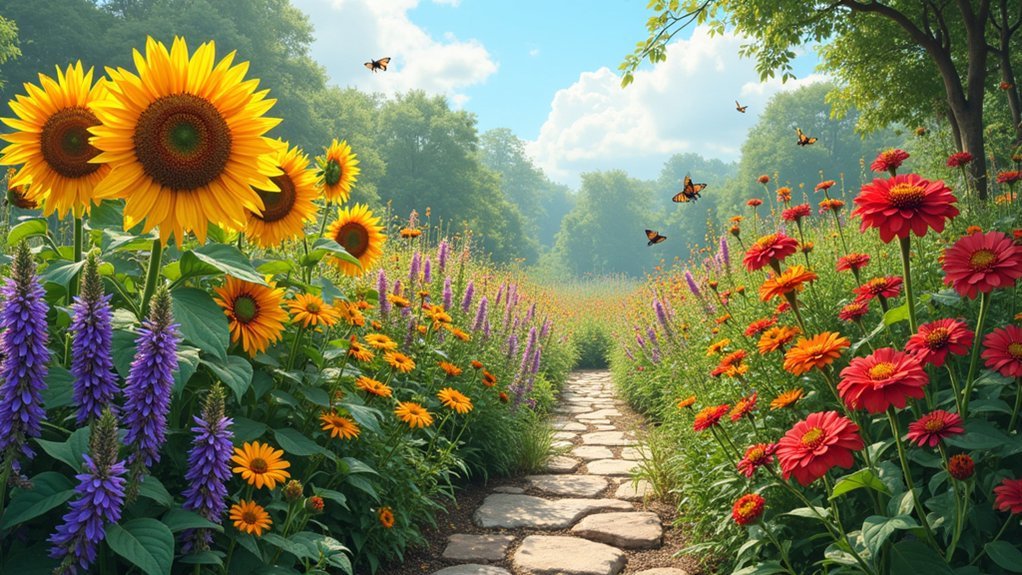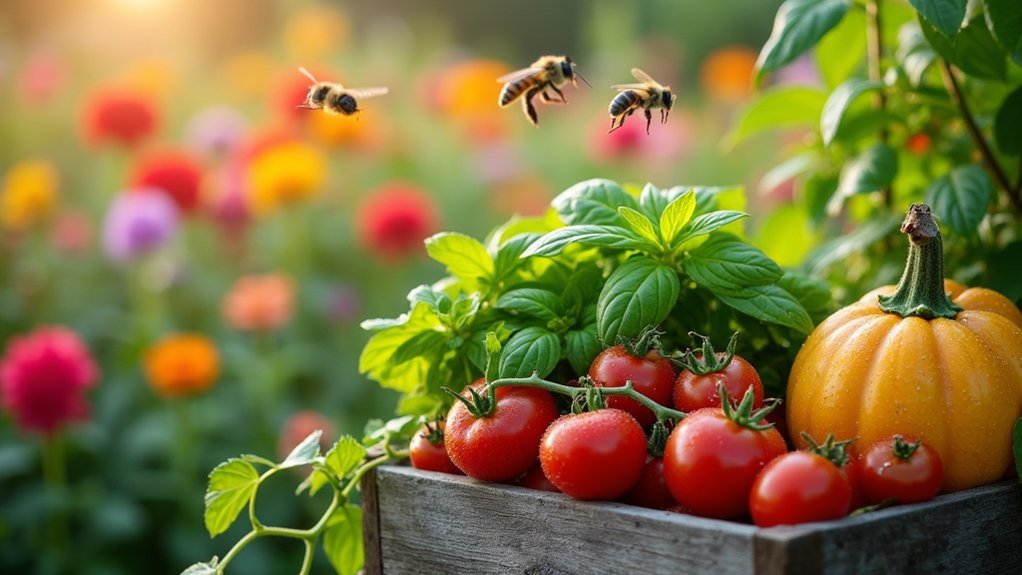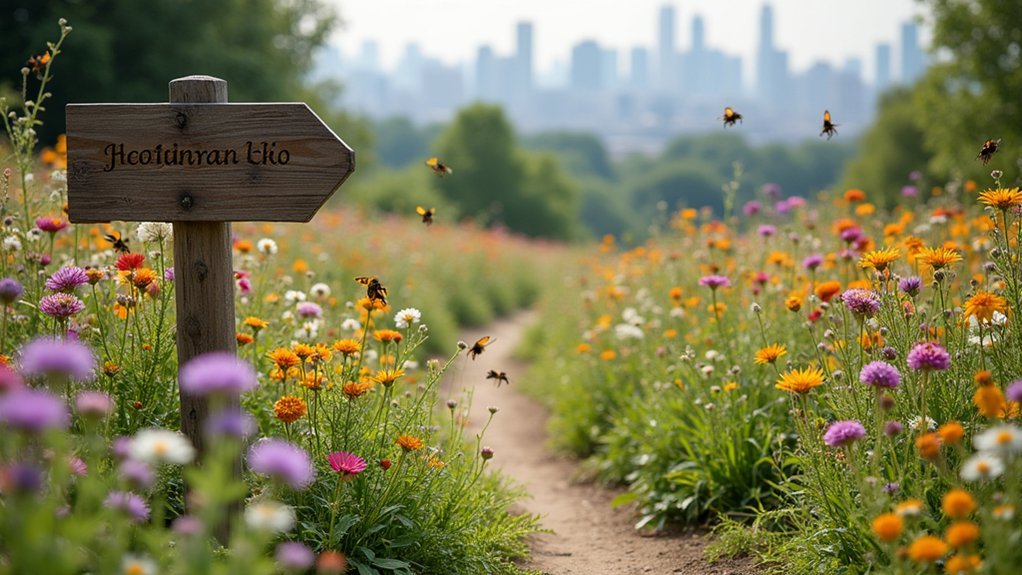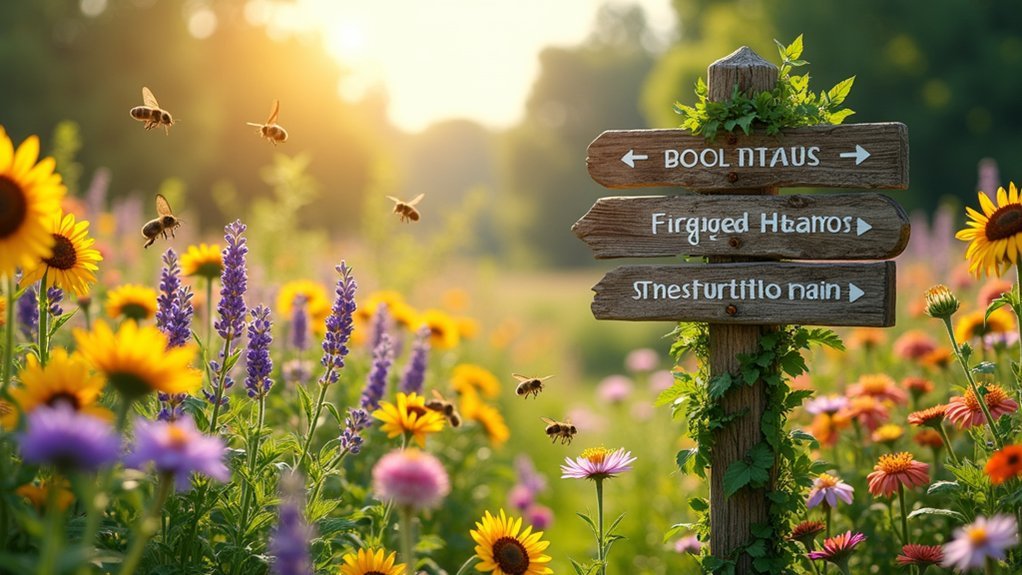Community pollinator gardens offer more than beautiful flowers—they're edible landscapes where you can forage for wild foods while supporting local biodiversity. You'll discover native plants like dandelions, serviceberry, and clover that nourish both people and pollinators. These gardens create essential corridors in urban environments, connecting green spaces and enhancing food production. By mapping seasonal blooms in your neighborhood, you can create your own food trail that transforms concrete landscapes into thriving ecosystems full of surprising edible treasures.
Exploring Food Trails Through Community Pollinator Gardens

While many urban dwellers remain disconnected from their food sources, community pollinator gardens are emerging as essential links in local food trails.
These vibrant spaces do more than beautify urban areas—they create vital habitats for bees, butterflies, and other pollinators that directly impact your neighborhood's food production.
The Connection Between Urban Foraging and Pollinator Health
When you gather wild edibles throughout urban landscapes, you're actively supporting plant biodiversity that provides essential nectar and pollen sources for bees, butterflies, and other pollinators.
Your mindful foraging practices help preserve interconnected habitat networks that allow pollinators to travel safely between feeding and nesting sites.
Wild Edibles Boost Biodiversity
Although often overlooked, wild edible plants create an essential bridge between urban foraging and pollinator health.
When you gather dandelions or clover from your neighborhood, you're participating in an ecological practice that supports native plants vital for biodiversity.
Wild edibles contribute to pollinator health in four significant ways:
- They provide continuous nectar sources throughout growing seasons.
- They create diverse habitats that attract varied pollinator species.
- They help mitigate urban habitat loss by offering food in concrete jungles.
- They strengthen ecosystem resilience through plant diversity.
Foraging Preserves Habitat Networks
Since many urban dwellers began foraging in their neighborhoods, they've unintentionally created essential pollinator corridors that connect otherwise isolated green spaces.
Your foraging activities encourage the growth of native plants like dandelions and clover, which serve as vital food sources for early-season pollinators.
When you participate in community gardens or preserve wild edible spaces, you're building an interconnected pollinator habitat network that strengthens biodiversity throughout the urban landscape.
These networks allow bees, butterflies, and other pollinators to travel safely between feeding areas, enhancing their survival in concrete-dominated environments.
Seasonal Harvests Support Pollinators
The rhythmic cycle of seasonal harvesting creates a symbiotic relationship between urban foragers and local pollinators.
When you gather fresh foods from community spaces, you're participating in a practice that strengthens biodiversity and enhances pollinator habitats.
Your seasonal harvests directly support pollinators through:
- Creating continuous bloom cycles in pollinator gardens that provide year-round food sources
- Promoting cultivation of native plants that have co-evolved with local pollinator species
- Increasing awareness about pollinator needs as you learn to identify beneficial flowering plants
- Establishing diverse urban ecosystems where bees and butterflies can thrive alongside human food production
Mapping Your Neighborhood's Edible Pollinator Pathways
Creating a map of your neighborhood's edible pollinator pathways connects food-producing gardens while highlighting biodiversity hotspots where pollinators thrive.
You'll find community mapping surprisingly accessible with digital tools that let you mark seasonal blooms, fruit trees, and vegetable gardens that benefit bees and butterflies.
Your map can guide neighbors through seasonal harvest opportunities, showing when and where to find ripening berries, herbs, and vegetables along pollinator-friendly routes.
Connect Garden Food Routes
Mapping your neighborhood's edible pollinator pathways begins with recognizing the interconnected nature of food production and ecological health.
By creating links between community gardens, you're establishing corridors that benefit both local residents and native pollinators while promoting sustainable practices.
To connect garden food routes in your area:
- Identify existing gardens with pollinator-friendly plants and reach out to their caretakers about joining a neighborhood network.
- Map gaps between gardens where new plantings could create continuous pathways for bees and butterflies.
- Engage local organizations to help establish signage that educates visitors about the food-pollinator relationship.
- Organize community events that highlight how these connected gardens increase access to fresh produce while supporting biodiversity.
These connections transform isolated green spaces into a thriving ecosystem of food production and habitat preservation.
Community Mapping Made Easy
Once you understand the basics of pollinator pathways, creating a neighborhood map becomes surprisingly straightforward with today's digital tools. You'll find community mapping connects residents while documenting local biodiversity resources.
| Mapping Tool | Best Use | Community Benefit |
|---|---|---|
| Interactive Maps | Track native plants | Shows pollinator density |
| Mobile Apps | Document garden locations | Facilitates sharing |
| QR Codes | Link to plant information | Enhances education |
Start by identifying existing pollinator gardens in your area, noting which contain edible pathways. Collaborate with schools and local organizations to expand your data collection. As neighbors contribute their garden locations, you'll create a thorough resource showing how these spaces support both pollinators and your community food system. This visual representation helps everyone understand the interconnected nature of urban biodiversity.
Seasonal Harvest Navigation
As the seasons change, your neighborhood's edible pollinator pathways transform into living food maps that guide residents to fresh, local produce.
These pollinator gardens aren't just beautiful spaces – they're functional sources of nutrition and education.
Navigate your local edible landscape by:
- Tracking seasonal blooms of native flowering plants like Swamp Milkweed and Cardinal Flower, which offer edible components while supporting pollinators.
- Following community-created harvest maps that highlight where edible plants are ready for foraging.
- Participating in community education workshops to identify which pollinator-friendly plants provide food throughout the year.
- Connecting with urban farms along these pathways to learn sustainable harvesting techniques.
Seasonal Foraging Calendar for Urban Pollinator Gardens
The rhythm of urban pollinator gardens follows nature's carefully orchestrated timeline, providing essential resources for pollinators throughout the year.
You'll notice Virginia Strawberry blooming first, offering significant nectar for bees emerging from winter hibernation.
Summer transforms your pollinator gardens with vibrant Swamp Milkweed and Brown-Eyed Susan, attracting butterflies and native bees while strengthening urban ecosystem connections.
As fall approaches, your focus shifts to creating shelter through strategic plant decay and preserved dead branches.
Maximize seasonal foraging by planting diverse native plants with staggered blooming periods, ensuring continuous nutrition for pollinators.
Connect with your community through events like the Adirondack Pollinator Festival, where you'll learn about sustainable foraging practices and the important ecological roles these gardens play in our shared urban spaces.
From Buzzing Blooms to Dinner Plates: The Urban Harvest Cycle

Your urban garden's vibrant ecosystem creates a direct pipeline from flower to food, connecting pollinator habitats with your dinner table in an elegant symbiosis.
Community gardens flourish when you integrate pollinator-friendly spaces that support native bees and other essential pollinators.
The urban harvest cycle transforms your garden efforts into tangible benefits:
- Native bees visiting your pollinator gardens increase vegetable yields by up to 70% through efficient pollination.
- Diverse flowering plants extend your growing season, providing continuous food production.
- Community harvest events celebrate collective achievements while educating neighbors about pollinator-food relationships.
- Each garden harvest becomes a teaching moment, demonstrating how pollinator health directly affects your plate.
You're not just growing food—you're fostering an interconnected system where pollinators and people mutually thrive.
Community-Led Initiatives Transforming City Spaces Into Food Trails
Three remarkable transformations are happening across urban landscapes as community-led initiatives convert forgotten spaces into thriving food trails.
You'll find neglected lots becoming urban farms that nourish neighborhoods while supporting local pollinators essential for crop production.
These community-led projects integrate native plants strategically, creating interconnected habitats where bees, butterflies, and birds thrive alongside food crops. The result? Enhanced food sustainability and healthier harvests for everyone involved.
When you participate in educational programs hosted by urban growers, you're not just learning gardening techniques—you're joining a movement that recognizes the critical relationship between pollinator gardens and food security.
Volunteers and local organizations bring diverse perspectives to these spaces, turning ecological challenges into opportunities for community growth and environmental stewardship.
Creating Forager-Friendly Pollinator Habitats in Urban Settings

While urban environments often seem hostile to wildlife, transforming city spaces into forager-friendly pollinator habitats creates crucial ecological sanctuaries that benefit both humans and insects.
Urban havens aren't luxuries—they're ecological necessities bridging nature and city life for mutual survival.
You'll find these pollinator gardens serve multiple purposes in your community while supporting local biodiversity.
To create your own forager-friendly habitat:
- Plant diverse native plants that bloom sequentially throughout the season, ensuring continuous nectar and pollen sources.
- Incorporate water features like small ponds or birdbaths to attract pollinators and wildlife.
- Collaborate with local schools and organizations to increase community engagement and educational opportunities.
- Address food desert issues by combining edible plants with pollinator favorites, teaching sustainable food systems.
When you design with these principles, you're not just creating beautiful spaces—you're establishing crucial ecological corridors in concrete landscapes.
Wild Edibles That Support Native Pollinators in City Environments
Urban landscapes can serve as surprising havens for both wild edibles and vital pollinators when thoughtfully designed with dual-purpose plantings.
You'll find that common plants like dandelions, clover, and milkweed offer nutritious food while simultaneously providing essential nectar and pollen for native bees and butterflies.
By incorporating late-blooming native species such as goldenrod and asters into your community gardens, you're supporting pollinators preparing for winter while expanding your edible harvest.
Research confirms that diverse plantings markedly increase pollinator visitation in urban settings.
Consider adding multipurpose plants like serviceberry and blackcurrant, which produce edible fruits for you while their flowers sustain pollinators.
This creates a mutually beneficial relationship within urban ecosystems.
The integration of wild edibles alongside ornamentals in community gardens builds biodiversity while yielding fresh produce for everyone.
The Educational Value of Foraging Through Pollinator Gardens

Learning through direct experience in pollinator gardens creates powerful educational opportunities for community members of all ages.
When you participate in guided foraging activities, you'll develop a deeper connection to your local ecosystem while gaining practical food sourcing skills.
Pollinator gardens offer four distinct educational benefits:
- Hands-on identification – You'll learn to recognize both edible plants and their pollinator partners.
- Sustainable harvest techniques – You'll practice responsible foraging practices that preserve plant populations.
- Seasonal awareness – You'll understand when native plants flower, fruit, and seed.
- Ecological interconnections – You'll witness firsthand how pollinators support food production.
These immersive experiences transform abstract concepts into tangible knowledge, empowering you to become a more informed steward of both wild and cultivated food systems.
Sustainable Harvesting Practices for Urban Wild Food Trails
Harvesting wild foods from urban trails requires thoughtful practices that extend beyond basic plant identification. When foraging, you'll want to take only a small portion of each plant—never more than 30%—allowing continued growth and essential resources for pollinators that depend on these native plant species.
Community engagement in sustainable harvesting practices creates a shared responsibility for these valuable ecosystems. As you collect wild berries, herbs, and greens, remember that these plants serve dual purposes: nourishing both people and local wildlife.
Follow established guidelines: avoid overharvesting, respect wildlife habitats, and participate in educational programs that emphasize responsible foraging.
Building Resilient Food Systems Through Pollinator Networks

While many focus solely on crop production techniques, the foundation of truly resilient food systems lies in thriving pollinator networks.
You'll create stronger food security in your community by establishing pollinator gardens that support diverse ecosystems.
Creating resilience through pollinator networks means:
- Integrating native plants into urban agriculture initiatives to attract diverse pollinators
- Engaging community members in garden maintenance to foster ecological stewardship
- Following the Xerces Society guidelines to design effective pollinator-friendly spaces
- Connecting these gardens to existing food trails to maximize community benefits
These efforts particularly benefit underserved areas, where pollinator gardens can simultaneously address food insecurity and ecological challenges.
Frequently Asked Questions
How Do You Layout a Pollinator Garden?
Plant native flowers in clustered groups that bloom throughout the season. You'll want varied heights, sunny spots, and sheltered areas. Don't use pesticides, and remember pollinators need continuous food sources year-round.
What Is a Pollinator Sanctuary?
A pollinator sanctuary is a dedicated space you've created to support pollinators. It's where you'll provide food, shelter, and nesting sites for bees, butterflies, and other pollinating creatures throughout their life cycles.
What Is Pollinator Corridors?
Pollinator corridors are connected habitat pathways you'll find linking fragmented landscapes. They're routes where bees, butterflies, and other pollinators can safely travel between food sources, nesting sites, and breeding grounds throughout urban and rural areas.
What Is the Importance of Pollinator Gardens?
Pollinator gardens are essential because they provide habitats for bees and butterflies that pollinate our food crops. You'll help increase biodiversity, support food security, and protect threatened species when you create one.
In Summary
You're now part of a crucial ecological network that connects your plate to pollinator health. As you forge your neighborhood's food trails, you'll witness how urban wild spaces sustain both humans and wildlife. Keep exploring, harvesting mindfully, and sharing your knowledge. By nurturing these connections, you're helping build resilient food systems that will thrive for generations in our changing urban landscapes.





Leave a Reply